SynBio Life
'SynBio Life' refers to 'synthetic biological life in new media art' by using synthetic materials with a biological concept. It is providing with an understanding of the concept of synthetic biology and indicating a subtle boundary between binaries.
produced by: Yunjeong Jang (Yuni)
Introduction
'SynBio Life' refers to 'synthetic biological life in new media art' by using synthetic materials with biological data. This project includes the following three main parts -synthetic, biological, synthetic biological. Self-filmed yeast growth (budding) videos can represent the biological aspect of this work. Acrylic (a synthetic material, created during the Industrial Revolution) gears as the symbols of the industrial period are in synthetic. And the coded yeast video shot via projector on acrylic discs can be the synthetic biological part. The aim of this work is giving more close feeling to the public about new media art, by providing an understanding of the concept of synthetic biology. Furthermore, I intend to exemplify how seemingly binary matters can be combined, such as living and non-living, organic and inorganic and human and non-human by the development of interdisciplinary studies in technoscience especially researched about synthetic biology.
Concept and background research
'SynBio Life' is based on my MFA dissertation "Distance: Synthetic Life in New Media Art".
Distance in synthetics
During the late 90s and the first decade of the 21st century, the field of “new media art” began to emerge and develop with advances of technology. Such art is undervalued in the number of cultural spaces, not as many institutes like art galleries but social groups of the general public. It seems that the role of catalyst in this concept playing is a sense of psychological and physical distance. During my latest exhibition in Russia, which represented a new media art flow from the ’90s to nowadays, I was asked by one interviewer, “Does new media art have the same soul as classical fine arts?”. Thinking about this question later, I realised that some cultural spaces may be confused about the nature of new media art and its position on existing art spectrums. I reckon that it is this confusion which creates the psychological distance.
By psychological distance, I refer to a cognitive separation between the self and other instances such as persons, events, or times (Baltatescu S., 2014). In Construal-Level Theory (CLT; Liberman & Trope, 1998; Trope & Liberman, 2003), psychological distance is defined in several dimensions – temporal, spatial, social, and ‘hypothetical distance’ being considered the most important. Based on ‘hypothetically and probability distance’ (CLT; Koehler, 1991; Nisbett, 1993), a low-level, rather than a high-level construal of hypothetical events makes these events seem more likely to become real, or, in other words, makes them seem more probable.
Likewise, in new media art, using complex terminology and less understandable events can occur the hypothetical distance to the general public, more so than in forms of classical art. Through my personal experiences, many people are unfamiliar with new media art or new technologies; I am often told that my work is great, but that it is not fully understood. The art critic Efim Vodonos has stated that he is unable to critique new media artworks without understanding the processes and techniques they use.
Furthermore, the use of synthetic materials in new media art provokes a large psychological distance on account of the complexity of these materials in terms of their production processes, compared to materials used in classical arts. For example, classical painting uses wooden frames while new media art pieces may use plastics. The production of a wooden frame can be easily imagined in a few steps – finding, cutting, reshaping the wood. Making a wooden frame is easy. One can easily imagine the steps involved – find, cut, and reshape the wood. Making plastic products, however, is different. Plastic products need to go through machinery, making it difficult to imagine the steps involved without specialist knowledge about the manufacturing process. Ambiguous imagination generates probability distance (central limit theorem; CLT).
Based on CLT theory, many people believe that biological organisms are closer to humans than non-organic, synthetic, and artificial objects because we are biological organisms ourselves. In this point, I would like to address that "Synthetic Biology" can introduce its concept for making the less psychological distance between organic-inorganic, classical painting-new media art in terms of their frequent material approach.
Synthetic Biology
Over the last few decades, the interdisciplinary study of synthetic biology has achieved positive results. Synbio involves the artificial design and engineering of biological systems and living organism for functions of enhancing implementations for industry or biological research.
I suggest using ‘synthetic biology’ (such as biofuels and artemisinin) to shorten the psychological distance with synthetics compared to organics by using a research-creation approach, following the term research-creation practice (Chris Salter, 2015), in which the split between mind and body, epistemology and ontology, and human and nonhuman are blurred, messed up, and mixed together. With the great discoveries and creations in synthetics, some cultural spaces are already surrounded by synthetics and the boundary between organics and synthetics is blurring. Based on Salter’s concept, the more synthetic biology develops through research-creation practice, the smaller the gap between organics and synthetics becomes.
Radomska (2015) highlights that engaging with board mobilises philosophical inventiveness: it contributes to the creation of concepts that attend to the problem of life and works through the binary of the living/non-living, organic/inorganic, and human/nonhuman. More specifically, she proposes the concept of ‘uncontainable life, which refers to dynamic, non- teleological, multiplicitous forces and processes of transformation, and intensities that are constitutive of matter and always carry the potential for surplus’. As a sense of her concept, it is assumed here that synthetic biology (especially bioart) can be ‘the potential for surplus’.
Technical
WIP1 show (December 2018)
My initial design for gears used to have a rectangle box which contains the whole gearset. And the half-transparent sheet (frosted acrylic) is covering the gears for showing lights from inside. The wireless light bulbs are attached to 3 gears and planned to be mixed the colours when the cogs are rotating.
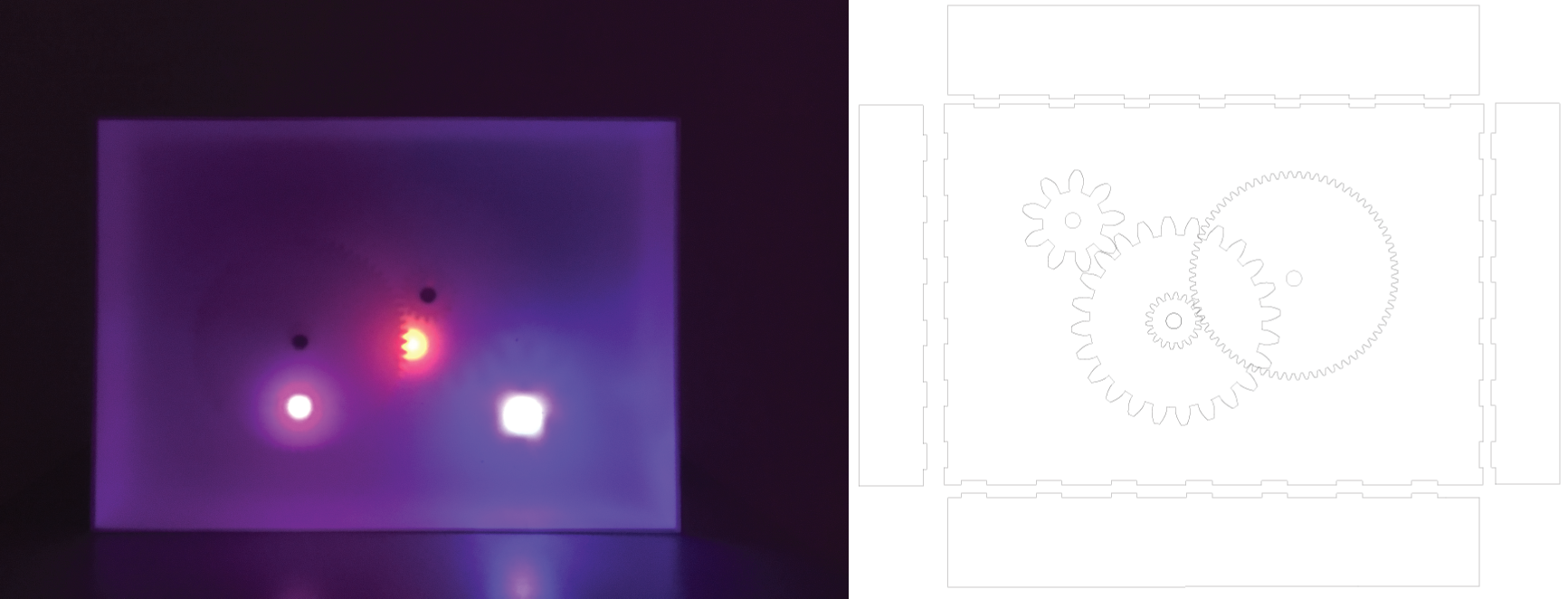
My first gear set with illustrator scheme. This is exhibited in WIP1 show (December 2018)
Practices in Russia exhibition
When I was preparing the Russia exhibition (Feburary 2019), I designed not only the upgraded version of the previous gear set but also created another form of the gear set. From this point, I put some symbols on the gears.
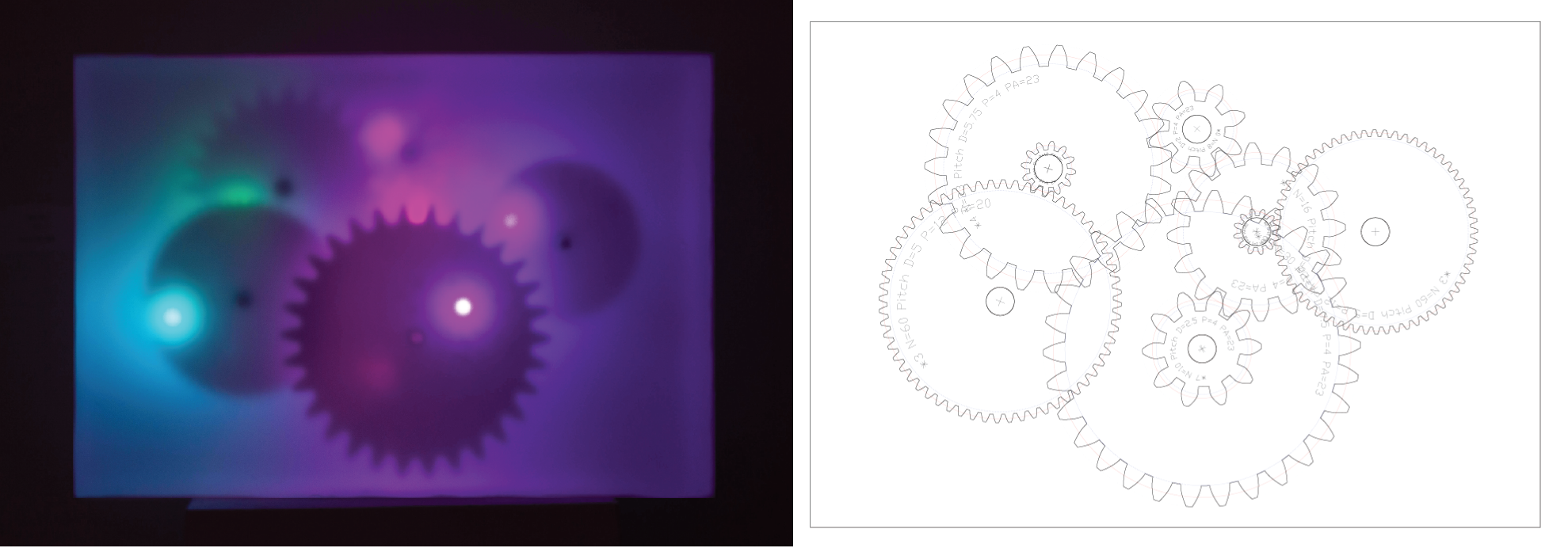
The upgraded version of the previous work. For better stability, I used 'gear generator'. This set consists of gear 3 layers and all gears are functional. Basically, I designed by using the gear generator to create cogs by each layer separately.
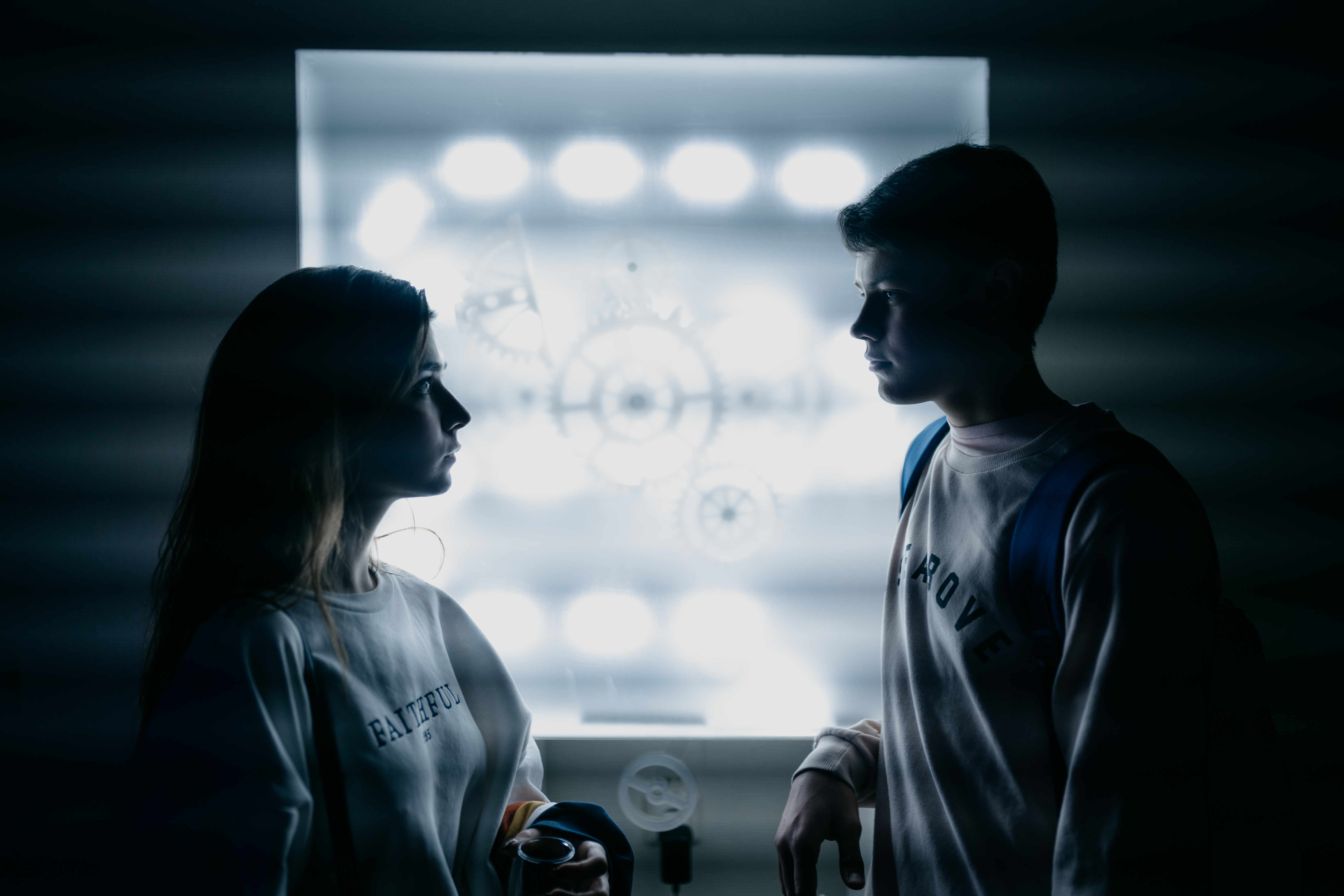
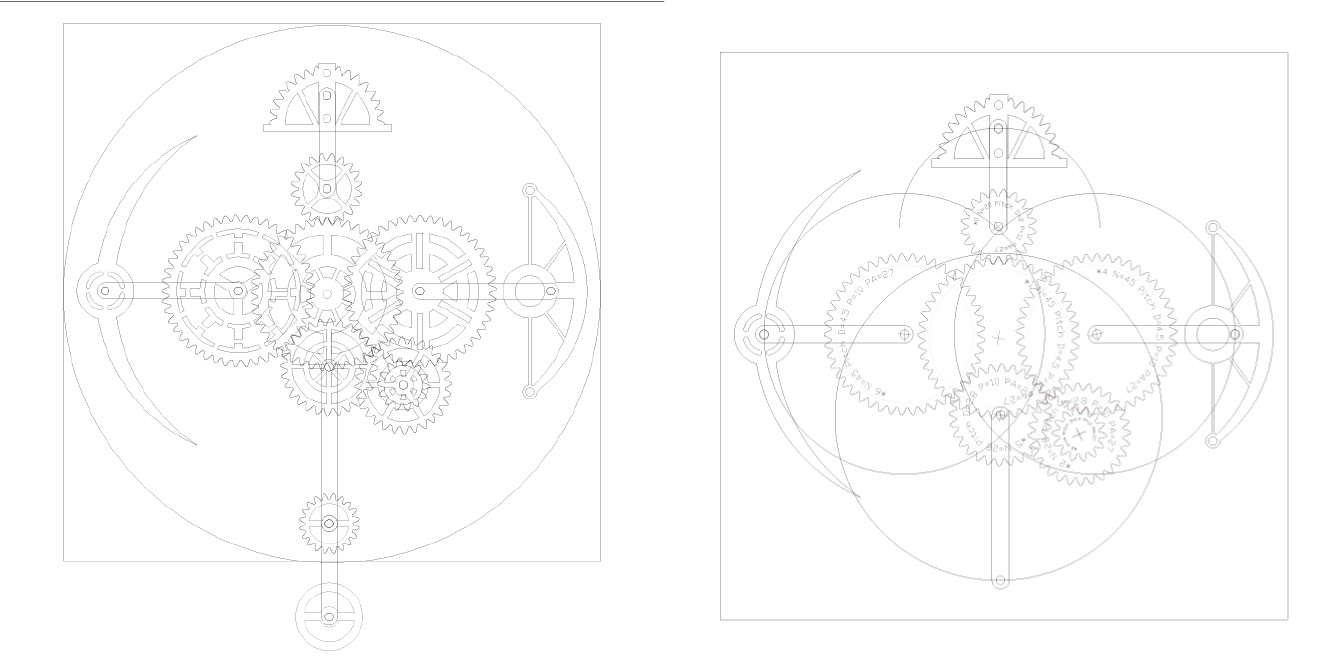
Another type of gear set which presents industrial symbols by acrylics and accessories
The initial draft for the final show
My first design plan for the final show was making massive one gear set and put some symbols with gears and making rotate (same as the Russia exhibition). In this case, the projector will be shot to the special panel or similar object. However, realistically this plan cannot be really successful because I should consider the symbols’ orbits. More specifically, the orbits shouldn’t touch any other parts in the gears, unless the movements will be restricted or smashed to each other. Also, it isn’t the right way to show my biological theme (I plan to show a few types of different biological video on the gear screens).
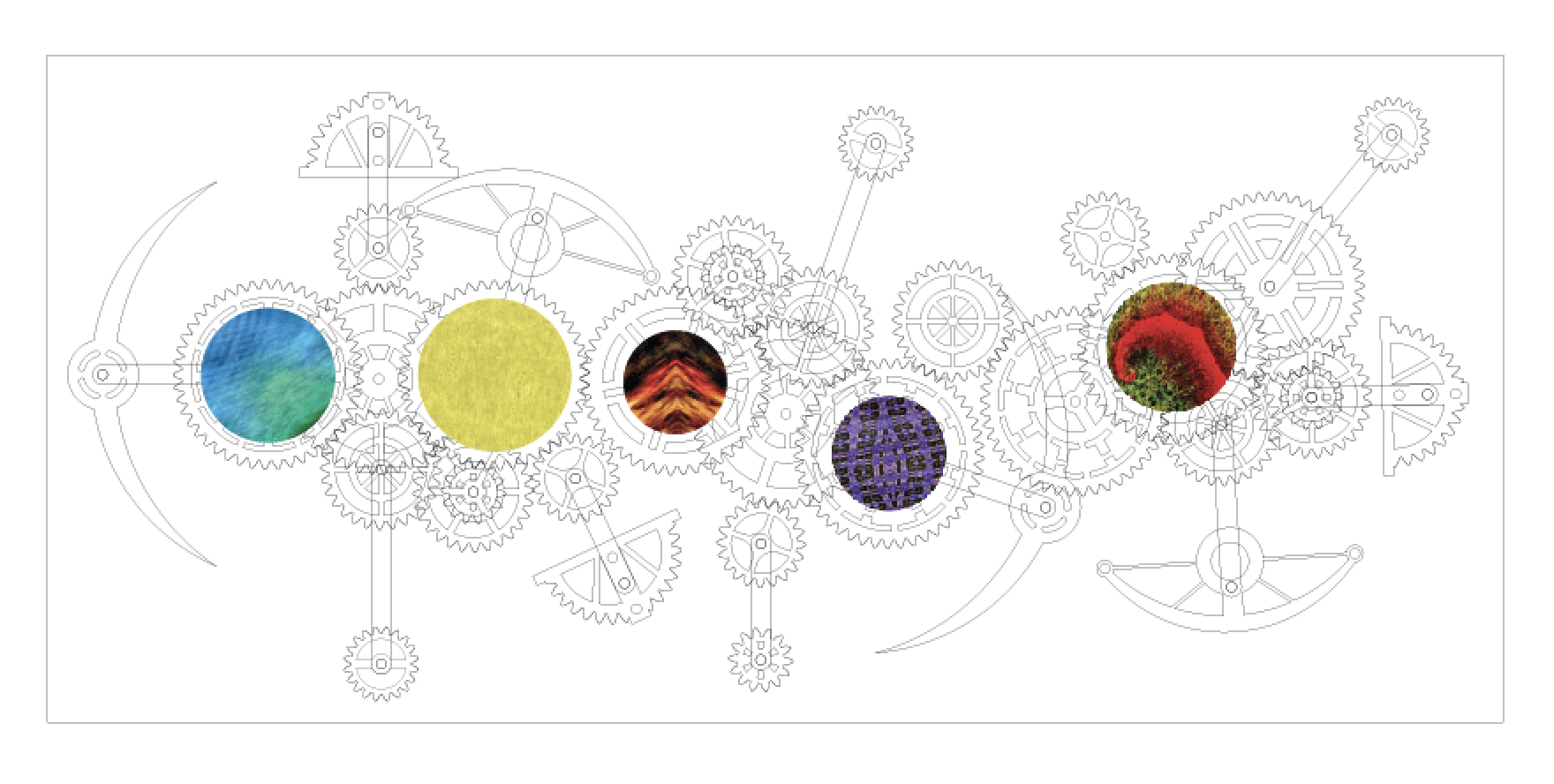
First draft planning of the final show
WIP 2 show (June 2019)
Previous practices, I preferred the automata concept but this time, I’d like to install a motor on the work. To make the more stable movement, coupler helped to connect the main axis -which is supposed to be attached to connected gear- with the servo motor. My servo motor’s head cog size was 6.35mm, so I used 6.35mm to 10mm (axis) on the 10mm diameter acrylic rod.
On the gear, I planned to shoot projector beams and show the computationally coded yeast growing video. I chose the yeast growing as the visual aspect because yeast is the biological things which can grow easily in the lab and also with a microscope, I can check the process of growth with the certain environment such as temperature, sunlight and humidity. To prepare WIP2 show, I didn’t have enough time to grow own yeasts myself, so I decided to use pre-recorded yeast video from “Microcinematography – Joseph V. Durden The Elementary Science Study Film loop ES-11 (1965 Educational Services Inc. (now Educational Development Center, Inc.))”.
For designing coded video, I schemed to use yeast dataset (Predicting the Cellular Localisation Sites of Proteins) to show the yeast are really growing or something is happening with the exact dataset. This time I adjusted the tint colour in the whole video.

Gears for the final
As being confirmed the theme as the synthetic biology and yeast growing, I would like to put different symbols on each gear sets. The biggest gears 800*800mm, I put the symbol of the industrial period and industry itself using the factory symbol, bridge and a pickaxe. The middle size set 600*600mm refers to the more biological concept through the one scene of cell segmentation and the smallest 450*450mm I put direct biology symbol.
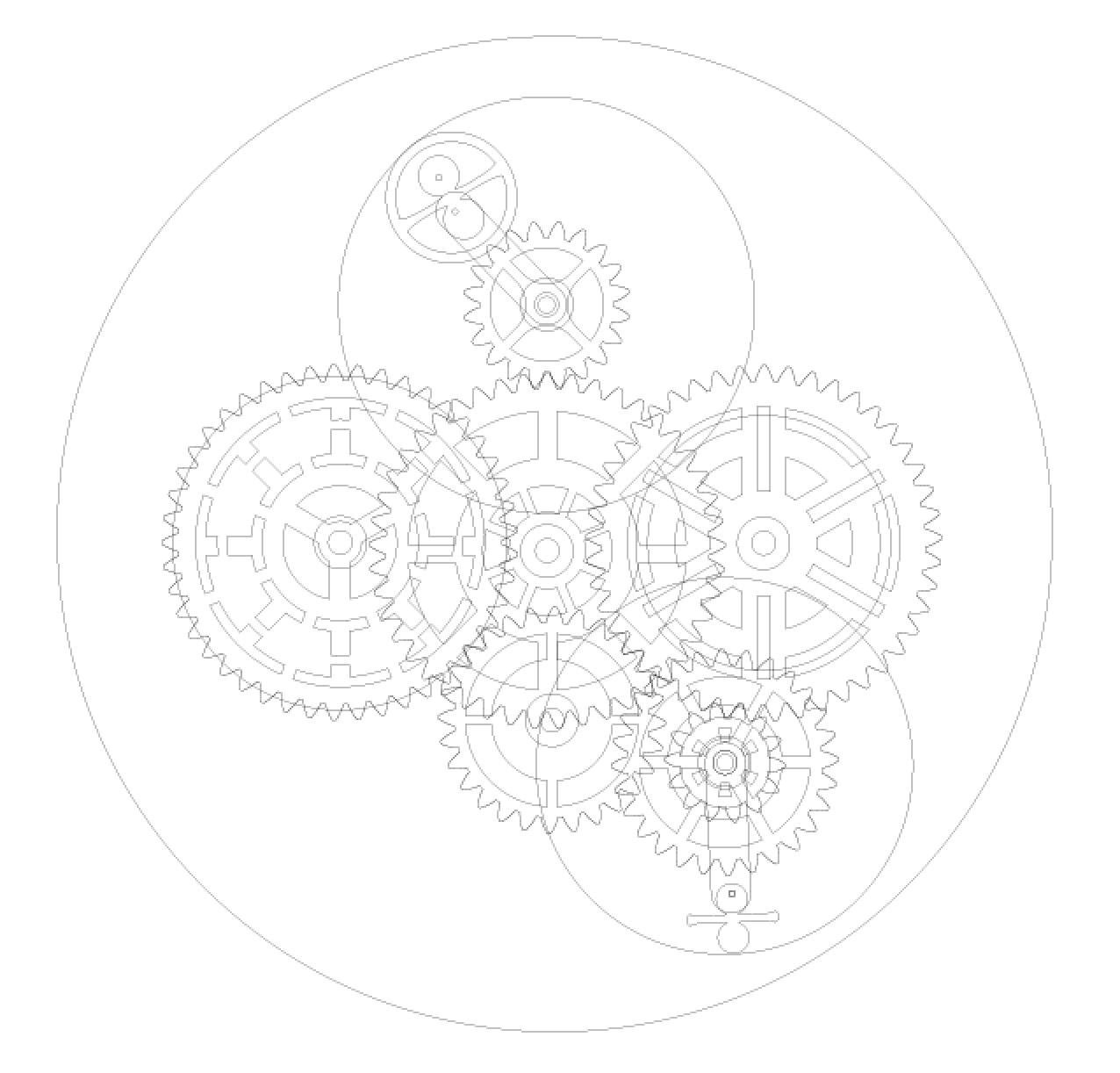
Middle size gear set (600*600mm) with cell's division symbols
Yeast Growth
To produce the steady and natural growth of yeast cells firstly I found and eject matter from “agaric honey” fungus which is widely spread in south Russia. To prepare the ground for growing I used sterile 3 lit jar and cover 20% of space with soil. However, according to do dry condition it was covered with 400 ml of water to produce steady evaporation for starting point. As fungus cells growing from consuming other decaying matters I add around 100 gram of white bread. After all, preparations were finished the fungus matter was injected into the central part of the soil and covered with bread. The next stage of the experiment was to provide growing conditions. Luckily the weather conditions at the beginning of July were highly friendly. During the day temperature was 26-28 degrees and drops to 19-22 during the night. Plus it was 4 raining days which provide a natural level of humidity. To prevent fungus death and self-consuming every 48 hours extra matter and water were injecting into the jar to produce more bacteriological food for the fungus. The experimental container was placed in protected from sun-rays space. However, opened for other influences. The full cycle of growing took around 1 week. During these procedures, I checked the yeast's movement (budding) with a microscope and filmed myself.
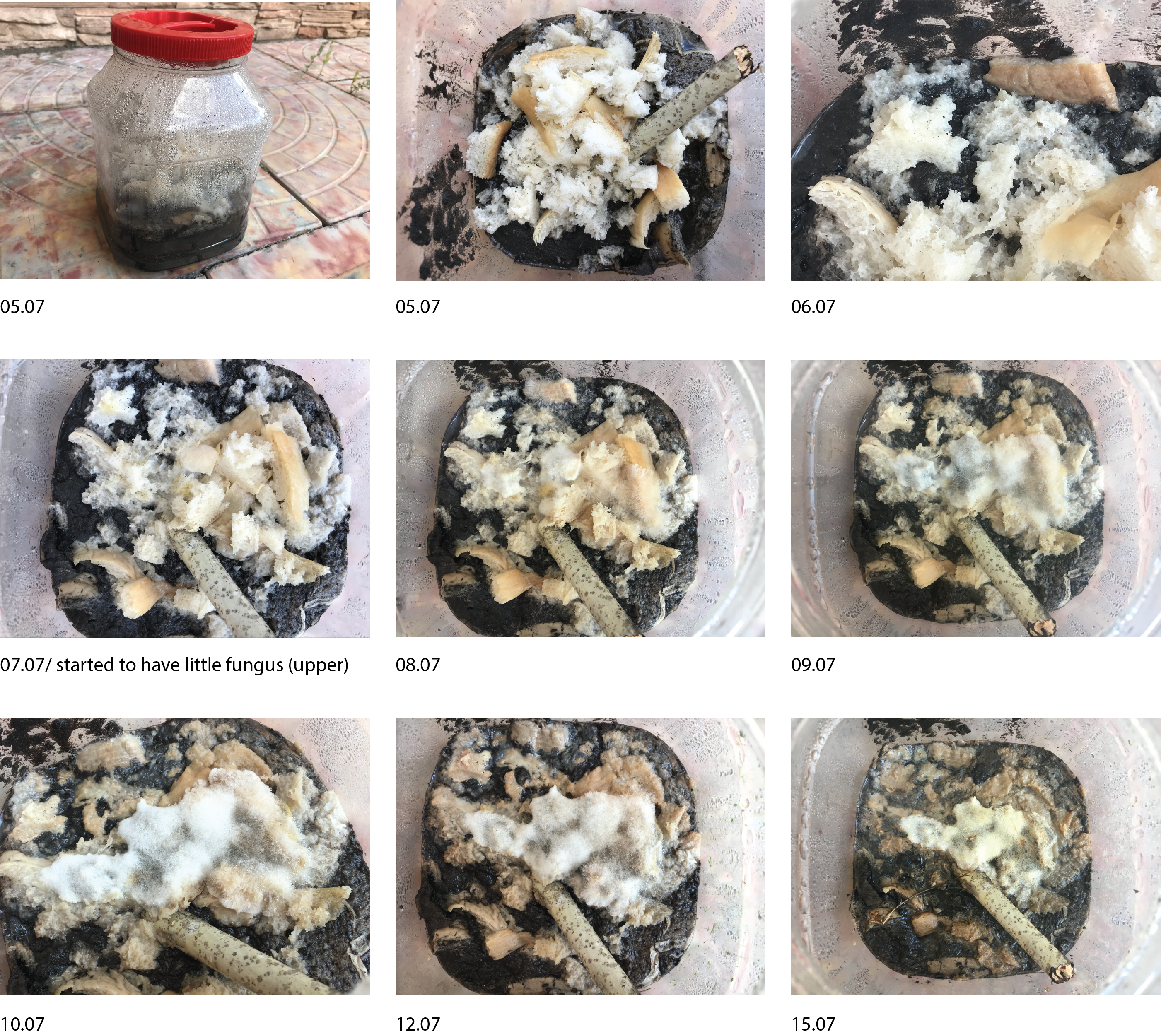
Fungus growth by dates (2019)

Captured image from the original microscopic video. 100x zoomed and filmed by iPhone 6.
Original Yeast Budding Videos
Coded video
Using my microscopic yeast video, I planned to modify the scenes using codes. Obviously, my yeast lab experiment was successful enough and the yeasts were activating lively while they're budding. On the other hands, by its own nature trait, they are not moving dramatically as I expected. When I tested the whole scenery with the original videos, it wasn't clear enough to see the movements. With Projection-Mapping, it seems like just a bit shaking. So, I decided to modify or add some particles when the videos appear differences with the previous frames. OpenCV for processing is the greatest library to find the difference with the previous scene and I also put some noises to show the motions. Another method I used was particle systems for showing lively motions. I put some particles around the scenes and it was a quite effective way to show more dramatic images. As a result, I created 3 videos (for each gear set) with 5 different scenes.
As I did in WIP2 show, I also used the same dataset for changing the colours of each video. This time I focused on much more subtle colour spectrum changes. The dataset I selected is Predicting the Cellular Localization Sites of Proteins. A believer of RNA world hypothesis myself, I reckon that proteins in yeast cells may be catalysts of persuading my whole concept through this practice.
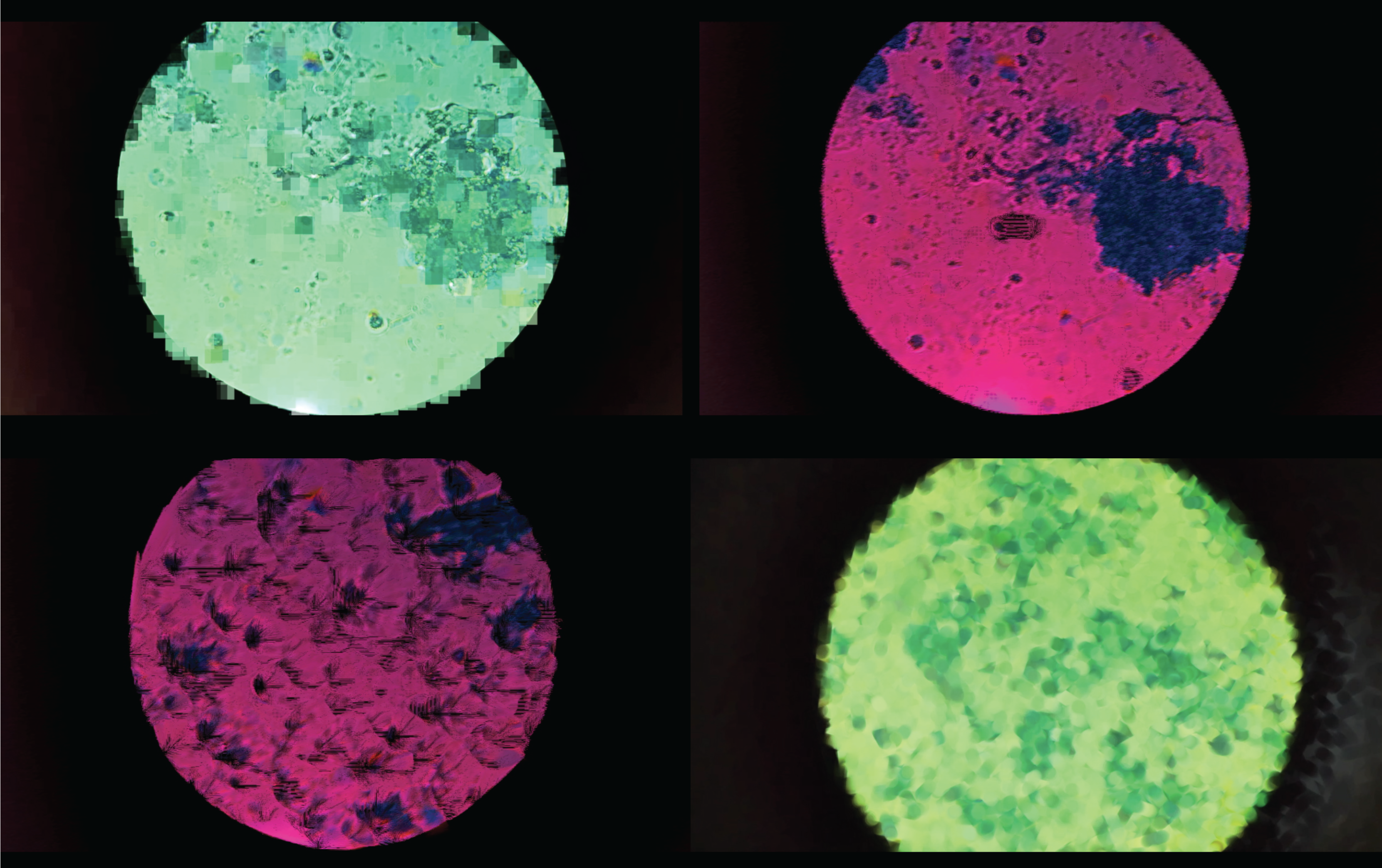 Few captured scenes from coded videos
Few captured scenes from coded videos
Controlling motors
My plan for controlling servo motors waw using the data with Wekinator and Arduino. However, when I put some data to the Arduino, the motor was incredibly lagging because of the fluctuating data. So, I ended up coding a sweep on my Arduino to the motor. I used 360-degree servo motors MG996R.
Future development
Since I have been interested in biological aspects in new media art especially synthetic biology, I have desired to build my own biological circuit for my artwork. This process can be worth both art and science field. My future plan for developing this topic is firstly learning biology, furthermore synthetic biology, for researching much deeply. Also, I want to have an experiment about checking the psychological feeling along with my researches. As a new media artist, my short future gold is applying synthetic biology to new technologies or new digital platform with practical outcomes which may be generating 3d environment via data from synthetic biology or modifying biofuels and create objects using novel digital platforms. Also attributing the possibility of evolution in synthetic biology and new media art will be the long term goal.
Self evaluation
In this full one year journey, all the experiments were not easy from the beginning to the final show. On the other hand, I've got quite a lot of feedback through tutorials and a few exhibitions. Because of those reviews, I could develop much further. Most of the difficulties had covered but still got some problems during the installation period. Due to both the direction of projector shooting and small space, I should put the projector on the floor so it occurred to build tilted shadows. Visually the shadows are gorgeous but still not fulfilling my aim. Next time, I decided that I'll plan the space more properly after this lesson.
References
Trope, Yaacov; Liberman, Nira (2010). "Construal-level theory of psychological distance". Psychological Review. 117 (2): 440–463. doi:10.1037/a0018963. PMC 3152826. PMID 20438233.
Nira Liberman, Yaacov Trope, and Elena Stephan, Psychological Distance, in Social Psychology: Handbook of Basic Principles (Arie W. Kruglanski and E. Tori Higgins (eds.); NY: Guilford Press, 2007) p. 354.
Baltatescu S. (2014) Psychological Distance. In: Michalos A.C. (eds) Encyclopedia of Quality of Life and Well-Being Research. Springer, Dordrecht
Osbourn AE, O'Maille PE, Rosser SJ, Lindsey K (November 2012). "Synthetic biology. 4th New Phytologist Workshop, Bristol, UK, June 2012". The New Phytologist. 196 (3): 671–7. doi:10.1111/j.1469-8137.2012.04374.x. PMID 23043589.
Jang, Y. (2019). Distance: Synthetic Life in New Media Art. [http://yunny.co.kr/?page_id=573]
Microcinematography – Joseph V. Durden The Elementary Science Study Film loop ES-11 (1965 Educational Services Inc. (now Educational Development Center, Inc.))
Dua, D. and Graff, C. (2019). UCI Machine Learning Repository [http://archive.ics.uci.edu/ml]. Irvine, CA: University of California, School of Information and Computer Science.
Radomska, Marietta. Uncontainable Life: A Biophilosophy of Bioart. Linköping University Electronic Press, 2016.
Salter, Chris. Alien Agency: Experimental Encounters with Art in the Making. Cambridge, Massachusetts, The Mit Press, 2015.
https://github.com/atduskgreg/opencv-processing
http://www.magicandlove.com/blog/2015/06/21/opencv-and-processing-10/
https://processing.org/reference/TableRow.html































































